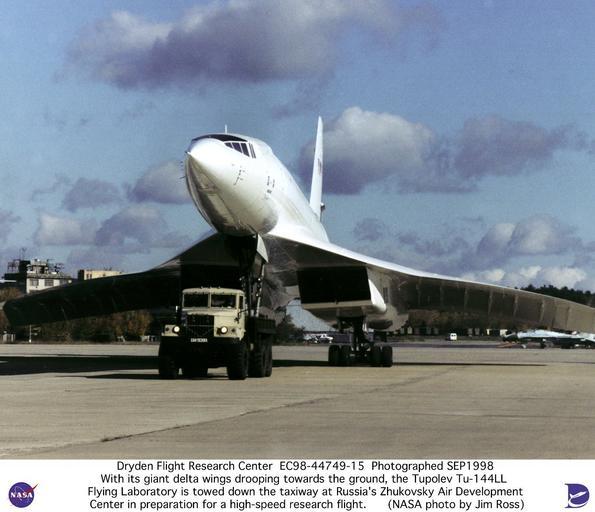MAKE A MEME
View Large Image

| View Original: | Tu-144LL_SST_Flying_Laboratory_Being_Towed_Down_Taxiway_DVIDS694138.jpg (1536x1321) | |||
| Download: | Original | Medium | Small | Thumb |
| Courtesy of: | commons.wikimedia.org | More Like This | ||
| Keywords: Tu-144LL SST Flying Laboratory Being Towed Down Taxiway DVIDS694138.jpg en With its giant delta wings drooping toward the ground the Tupolev Tu-144LL is towed down a taxiway at the Zhukovsky Air Development Center near Moscow Russia in preparation for a high-speed research flight in 1998 NASA teamed with American and Russian aerospace industries for an extended period in a joint international research program featuring the Russian-built Tu-144LL supersonic aircraft The object of the program was to develop technologies for a proposed future second-generation supersonic airliner to be developed in the 21st Century The aircraft's initial flight phase began in June 1996 and concluded in February 1998 after 19 research flights A shorter follow-on program involving seven flights began in September 1998 and concluded in April 1999 All flights were conducted in Russia from Tupolev's facility at the Zhukovsky Air Development Center near Moscow The centerpiece of the research program was the Tu 144LL a first-generation Russian supersonic jetliner that was modified by its developer/builder Tupolev ANTK aviatsionnyy nauchno-tekhnicheskiy kompleks-roughly aviation technical complex into a flying laboratory for supersonic research Using the Tu-144LL to conduct flight research experiments researchers compared full-scale supersonic aircraft flight data with results from models in wind tunnels computer-aided techniques and other flight tests The experiments provided unique aerodynamic structures acoustics and operating environment data on supersonic passenger aircraft Data collected from the research program was being used to develop the technology base for a proposed future American-built supersonic jetliner Although actual development of such an advanced supersonic transport SST is currently on hold commercial aviation experts estimate that a market for up to 500 such aircraft could develop by the third decade of the 21st Century The Tu-144LL used in the NASA-sponsored research program was a D model with different engines than were used in production-model aircraft Fifty experiments were proposed for the program and eight were selected including six flight and two ground engine tests The flight experiments included studies of the aircraft's exterior surface internal structure engine temperatures boundary-layer airflow the wing's ground-effect characteristics interior and exterior noise handling qualities in various flight profiles and in-flight structural flexibility The ground tests studied the effect of air inlet structures on airflow entering the engine and the effect on engine performance when supersonic shock waves rapidly change position in the engine air inlet A second phase of testing further studied the original six in-flight experiments with additional instrumentation installed to assist in data acquisition and analysis A new experiment aimed at measuring the in-flight deflections of the wing and fuselage was also conducted American-supplied transducers and sensors were installed to measure nose boom pressures angle of attack and sideslip angles with increased accuracy Two NASA pilots Robert Rivers of Langley Research Center Hampton Virginia and Gordon Fullerton from Dryden Flight Research Center Edwards California assessed the aircraft's handling at subsonic and supersonic speeds during three flight tests in September 1998 The program concluded after four more data-collection flights in the spring of 1999 The Tu-144LL model had new Kuznetsov NK-321 turbofan engines rated at more than 55 000 pounds of thrust in full afterburner The aircraft is 215 feet 6 inches long and 42 feet 2 inches high with a wingspan of 94 feet 6 inches The aircraft is constructed mostly of light aluminum alloy with titanium and stainless steel on the leading edges elevons rudder and the under-surface of the rear fuselage NASA Identifier NIX-EC98-44749-15 2009-09-23 Glenn Research Center https //www dvidshub net/image/694138 694138 2012-10-10 13 13 WASHINGTON DC US PD-USGov Langley Research Center Images from DoD uploaded by Fæ | ||||